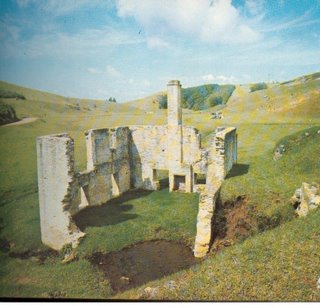
JAMES DAWE THE MILLWRIGHT
When Bernie was a boy, the land stretching right up Queen Elizabeth Avenue from where Hillcrest Hotel now stands right up to the corner at Middlegate, was known as "Dawe's Land." The seven acres where our home "Devon" was built in the 1920's was also part of "Dawe's Land".
This land, totalling about 54 acres, was granted in 1859 to a James Dawe, who was a miller.
When the Pitcairners were moved to Norfolk Island from Pitcairn, the Colonial authorities, in their wisdom, decided to bring out from England a small group of people who would provide some skills which were not available in the Pitcairn community. This included a man called Blinnan, a stonemason, and Rossiter, a schoolteacher. There was also a shoemaker and an agriculturalist.
These men were enticed to leave their homes and employment in England with the promise of a free passage for themselves and their families, and a free grant of land on Norfolk Island.
James Dawe, who came from Cornwall, but who had studied much of his trade in Devon, arrived with his wife Mary Ann and one child (one seems to have died en route) in June 1859. Two more children were born while he was here.
Dawe did not find things easy on the island, and he appears to have regrets about leaving behind his home and business in England. The two mills on the island were in a bad state of repair, especially the windmill. He decided to concentrate on getting the watermill (whose ruins are pictured above) into good working order. He was hampered by lack of proper financial assistance, but his worst problem came from an apparent lack of interest and co-operation from the Pitcairners.
Not only were they unwilling to lend a hand with the physical work, but showed little interest in learning to either grow or grind the grain. What we should remember is that this community had come from a small tropical island, and had a strong Polynesian ethnic and cultural base. Large scale cultivation in the European style was foreign to them. In any case, the starch part of their diet was more likely to come from such things as kumera, yam, maize and arrowroot, rather than from bread and wheat flour.
Dawes also complained that the Bounty people seemed to want to be left alone, and resented the presence of outsiders in their community. There must have been a real clash of cultures, something that the well-meaning but insensitive colonial authorities had not considered. The only one of these newcomers who ended up staying and marrying into the island families was Thomas Rossiter. But he was the only one who had a guaranteed income, a princely 300 pounds a year!
Dawe appears to have lived in a convict built cottage close to the Watermill. We do not know if he used his grant to grow anything for his own needs apart from cattle, but we do know that by 1861, he was leasing the land to the Sawmill Company, owned by Charles Christian.
By 1862, Dawe had decided to cut his losses and move his family to Sydney. He sold his land to Charles Christian. This was the very first sale of land in the post-convict era. Charles paid 30 pounds for the 54 acres, but he also paid 17 pounds for 7 cattle belonging to Dawes, and we still have the receipt!

I have often wondered how Charles( a grandson of Fletcher Christian) could have accumulated sufficient cash to deal in property at that early stage, but they say he was a very entrepreneurial man, and sold produce and supplies to the Mission ship "Southern Cross" and to other passing vessels, including whaling ships.
Charles apportioned the land to some of his 16 offspring, including 20 acres to his daughter Emily (who was Bernie's great-grandmother.) Of course, as was the custom, the land was put in the name of her husband George Bailey.) Emily and George bequeathed the 7 acres where Devon stands to their daughter Charlotte, who left it to her great-nephew Bernie (my husband.)
Today we had a visit from Margaret Smith of Castle Hill in Sydney. Margaret is descended from Dawe's son James Greenland Dawe, who was born on Norfolk Island. By a remarkable coincidence, James' granddaughter Alice married a great-great grandson of Nathaniel Lucas, who was on Norfolk Island in the convict settlement. Now Nathaniel Lucas had been responsible for helping build those mills!
Next time I shall tell you about another remarkable coincidence, where other previous owners and occupiers of "Devon" turn out to have an interesting connection!
1 comment:
Hi Mary,
my Husband is a descendant of James Dawes. I would love it if you would liek to contact us. Email is nkgoode@bigpond.com
Post a Comment